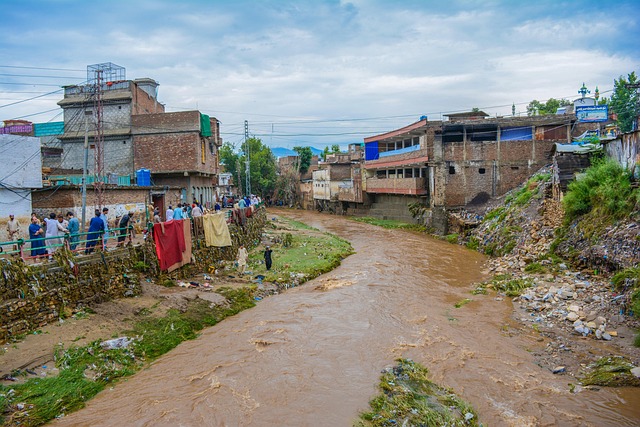1. How Climate Change Is Intensifying Flood Destruction Across Pakistan
Climate change has become a major catalyst behind the increasing flood destruction in Pakistan. In recent years, the country has experienced more frequent and intense weather events, particularly torrential rains and flash floods. Rising global temperatures have altered monsoon patterns, making them more unpredictable and powerful. As a result, flood-prone regions like Sindh, Balochistan, and South Punjab are now facing widespread devastation nearly every year. These floods are not just seasonal inconveniences; they destroy homes, infrastructure, and livelihoods, leaving millions in distress. The link between climate change and extreme weather is now well-established, and Pakistan is emerging as one of the most vulnerable countries to its effects. The intensity and duration of rainfall events are exceeding historical norms, overwhelming river systems and drainage infrastructure that were never designed to handle such volumes.
The implications of climate change-induced flood destruction in Pakistan are profound. Besides the immediate loss of lives and property, there are long-term consequences like soil erosion, water contamination, and increased poverty. The frequent occurrence of destructive floods creates a cycle of vulnerability, where communities are unable to recover before the next disaster strikes. This not only puts pressure on local governments and disaster response agencies but also threatens the country’s overall economic stability. Flood destruction, fueled by climate change, has transformed from a seasonal issue into a chronic national crisis. Without urgent action on climate resilience and sustainable development, the destruction will only worsen in the coming decades. Addressing this issue must be a priority for policymakers, urban planners, and international climate bodies alike.
2. The Human Cost of Flood Destruction: Displacement and Loss in Pakistan
One of the most devastating effects of flood destruction in Pakistan is the large-scale displacement of people. During the 2022 floods alone, more than 33 million people were affected, with millions losing their homes and being forced to live in makeshift shelters. The scale of human suffering is staggering. Families are torn apart, livelihoods are destroyed, and basic necessities such as food, clean water, and medical aid become scarce. For many, flood destruction means starting life from zero without jobs, property, or support systems. Children often miss out on school for months, and diseases spread rapidly in overcrowded relief camps. Displacement also triggers social instability, increasing poverty and deepening existing inequalities.
Flood destruction caused by climate change disproportionately affects marginalized communities, especially those living in low-lying and rural areas. These people often lack the resources to rebuild or relocate, making them highly vulnerable to repeated disasters. The psychological toll is also immense constant fear of losing everything again can be paralyzing. Moreover, many displaced individuals do not receive adequate support or compensation from the government, forcing them into cycles of debt and dependence. The humanitarian crisis triggered by flood destruction in Pakistan is not just a consequence of natural forces it’s a result of systemic neglect and insufficient planning. If Pakistan is to protect its people, there needs to be a serious investment in climate adaptation, emergency response systems, and long-term rehabilitation plans.
3. From Glacial Melt to Monsoon Chaos: Root Causes of Flood Destruction in Pakistan
Flood destruction in Pakistan is deeply rooted in a combination of natural and man-made causes, with climate change acting as a powerful accelerator. One of the major contributors is glacial melt in the northern mountainous regions, especially in Gilgit-Baltistan and Khyber Pakhtunkhwa. As global temperatures rise, glaciers in the Himalayas and Karakoram are melting at alarming rates. This leads to glacial lake outburst floods (GLOFs), where large volumes of water are suddenly released, causing flash floods downstream. In addition to glacial melt, Pakistan’s monsoon season has become increasingly erratic and intense, bringing torrential rains that overwhelm riverbanks and urban drainage systems. Together, these phenomena contribute to widespread flood destruction each year.
Another major root cause is poor land and water management. Deforestation, unregulated construction on riverbanks, and outdated irrigation infrastructure further amplify the risks. Rivers like the Indus, Ravi, and Sutlej, which once supported agriculture and livelihoods, are now becoming unpredictable and dangerous. The lack of early warning systems and real-time data sharing among provinces also hampers timely response efforts. As a result, communities are often caught off guard, leading to greater losses. Understanding the root causes of flood destruction is crucial for developing effective mitigation strategies. This requires not only scientific research and technological innovation but also collaboration between local governments, environmental experts, and international partners.
4. Rural Devastation: How Flood Destruction Impacts Pakistan’s Agricultural Heartland
Pakistan’s rural economy is heavily reliant on agriculture, making it especially vulnerable to flood destruction. Provinces like Punjab and Sindh, which are the country’s primary agricultural zones, suffer enormous losses every flood season. Torrential rains and overflowing rivers destroy standing crops, wash away fertile topsoil, and damage irrigation systems. This leads to reduced yields of key crops like wheat, rice, and cotton, which in turn threatens national food security. For small farmers who rely on seasonal harvests for their income, a single flood event can mean months if not years of financial hardship. Agricultural equipment and livestock are also lost, making recovery even more difficult.
Flood destruction in rural areas doesn’t just impact local farmers it affects the entire food supply chain. With reduced agricultural output, food prices skyrocket in urban markets, impacting millions of consumers. Furthermore, the destruction of infrastructure like roads and storage facilities disrupts distribution networks, causing delays and spoilage. Women and children in rural communities are particularly affected, as they often depend on small-scale farming or livestock to sustain their households. Long-term impacts also include increased rural-to-urban migration, which puts pressure on already strained city resources. To prevent rural devastation, Pakistan must invest in flood-resilient farming techniques, build stronger embankments, and provide insurance schemes to safeguard farmers against climate-related losses.
5. Urban Flood Destruction in Pakistan: Are Cities Prepared for Climate Extremes?
Urban areas in Pakistan are facing unprecedented challenges due to climate change-driven flood destruction. Cities like Karachi, Lahore, and Islamabad frequently experience urban flooding during monsoon season, disrupting daily life and damaging critical infrastructure. One of the primary causes is unplanned urbanization natural drainage systems have been replaced with concrete, while encroachments on waterways block the natural flow of rainwater. Inadequate waste management systems further clog drains, exacerbating flood damage. In 2020, Karachi witnessed severe urban flooding that submerged roads, homes, and hospitals, leaving residents stranded for days. Such incidents highlight the urgent need to rethink urban planning in the face of a changing climate.
The economic cost of urban flood destruction is massive. Businesses are forced to shut down, public transport grinds to a halt, and emergency services struggle to reach affected areas. The poor and lower-middle-class residents living in informal settlements face the brunt of the damage, as their homes are often located in high-risk zones. The lack of coordinated disaster response and early warning systems adds to the chaos. Climate change has turned sporadic rainfall into a high-stakes hazard, and without investment in sustainable infrastructure, the situation will only deteriorate. Pakistan’s urban centers must adopt smart drainage systems, enforce zoning laws, and integrate climate resilience into all aspects of city development.
6. Infrastructure in Ruins: The Economic Fallout of Flood Destruction in Pakistan
Flood destruction in Pakistan has a devastating impact on national infrastructure, leading to billions in economic losses each year. Roads, bridges, power lines, and dams are frequently damaged or destroyed, cutting off essential services and isolating entire communities. Rebuilding this infrastructure places an immense financial burden on the government, diverting funds from critical sectors like education and healthcare. The repeated loss of infrastructure due to floods stalls economic growth, discourages investment, and increases unemployment. Industrial zones located near rivers are often submerged, halting production and damaging machinery. The floods of 2022 alone caused over $30 billion in economic damages an amount the country can scarcely afford.
The destruction of infrastructure also undermines disaster recovery efforts. Relief supplies can’t reach affected areas, hospitals become inaccessible, and communications networks are disrupted. Poorly constructed roads and bridges, often built without proper climate risk assessments, fail to withstand floodwaters, resulting in higher casualties and longer recovery times. In rural areas, the damage to irrigation canals and storage systems leads to long-term agricultural setbacks. To protect its economic future, Pakistan must make infrastructure climate-resilient by enforcing stricter building codes, investing in modern engineering solutions, and incorporating environmental impact assessments in all development projects. Without these steps, flood destruction will continue to cripple the country’s progress.
7. The Role of Deforestation and Land Misuse in Worsening Flood Destruction
Deforestation is one of the most overlooked yet critical factors that worsen flood destruction in Pakistan. Forests play a key role in stabilizing soil, absorbing rainfall, and slowing down water runoff. However, in many parts of the country especially in Khyber Pakhtunkhwa and the northern areas rapid deforestation due to illegal logging and land conversion has stripped the land of its natural defense systems. When heavy rains hit these regions, there’s nothing to slow the water, leading to flash floods and landslides that wreak havoc downstream. Land misuse, such as unplanned urban expansion, encroachment on riverbanks, and poor agricultural practices, further aggravate the problem by disrupting natural water flow and increasing soil erosion.
The destruction of forest cover and wetlands not only increases the volume and velocity of floodwaters but also reduces the land’s capacity to recover from repeated flood events. Villages, roads, and farmlands located near deforested areas are now at higher risk of repeated flood destruction. Restoring Pakistan’s green cover is not just an environmental concern it’s a vital part of disaster risk reduction. Reforestation, protection of watersheds, and enforcement of land-use laws must become top priorities for the government. Without action, the unchecked misuse of land will continue to magnify the deadly impact of floods and turn seasonal rains into recurring national catastrophes.
8. Children and Women at Risk: Vulnerable Groups in Pakistan’s Flood Destruction Zone
Flood destruction in Pakistan doesn’t affect everyone equally women and children are among the most vulnerable during and after such disasters. In flood-hit areas, they often face limited access to food, clean water, and healthcare. Pregnant women are especially at risk due to disrupted medical services, while children suffer from malnutrition and waterborne diseases like cholera and diarrhea. During the 2022 floods, over 3 million children were in need of urgent humanitarian assistance. Temporary shelters often lack proper sanitation and privacy, increasing the risk of gender-based violence and mental health issues among displaced women and girls. These are not just side effects they are central human rights concerns that need focused attention.
Flood destruction also disrupts education for thousands of children. Schools are either destroyed or used as emergency shelters, leading to long-term learning loss. Many girls, in particular, never return to school after such disasters due to financial strain or societal pressure. Meanwhile, women in rural communities lose their small-scale farming operations or home-based businesses, pushing them deeper into poverty. Addressing the needs of vulnerable groups must be integrated into Pakistan’s disaster management strategy. Relief efforts should include child protection services, maternal care, gender-sensitive shelters, and targeted financial aid. Only then can we ensure that recovery from flood destruction is inclusive and sustainable for all.
9. Disaster Response in Pakistan: Are We Ready for the Next Wave of Flood Destruction?
As flood destruction in Pakistan becomes more severe due to climate change, the country’s disaster response systems are being put to the test. Unfortunately, these systems remain underfunded, poorly coordinated, and reactive rather than proactive. The National Disaster Management Authority (NDMA) has made progress in recent years, but early warning systems, evacuation planning, and community preparedness are still lacking in many flood-prone areas. In rural regions, many residents are unaware of the flood risks or receive alerts too late to take action. The 2022 floods revealed major gaps in coordination between federal, provincial, and local authorities leading to delays in relief, rescue, and rehabilitation efforts.
To reduce the impact of future flood destruction, Pakistan needs a holistic and well-resourced disaster response framework. This includes investments in weather monitoring technology, mobile alert systems, emergency shelters, and trained rescue personnel. Schools and mosques can be equipped as temporary relief centers with adequate supplies. Community-based disaster training programs can also empower locals to act quickly during emergencies. Climate change has made flooding more frequent and intense, and without a prepared response system, each event turns into a humanitarian crisis. Strengthening disaster response isn’t just about saving lives it’s about enabling faster recovery and long-term resilience
10. Climate Justice and Flood Destruction: Why Pakistan Pays for Global Emissions
One of the most alarming aspects of flood destruction in Pakistan is that the country contributes less than 1% to global greenhouse gas emissions, yet it ranks among the top nations most affected by climate change. This imbalance brings up a serious issue of climate justice. Developed countries, whose industrial activities have historically contributed to rising global temperatures, bear responsibility for the climate crisis. Yet it is countries like Pakistan that face the worst consequences repeated floods, economic setbacks, displacement, and loss of life. The 2022 floods were labeled a “climate catastrophe” by international organizations, but financial assistance and climate reparations have been minimal.
Climate justice demands that wealthier, high-emission countries provide meaningful support to vulnerable nations like Pakistan. This includes funding for climate adaptation, debt relief, and compensation for loss and damage. Global climate summits often include such discussions, but concrete actions remain limited. Pakistan must advocate more strongly on international platforms to secure its fair share of climate finance. At the same time, it must use such support efficiently to invest in sustainable infrastructure, disaster management, and community resilience. Only through global accountability and national preparedness can Pakistan hope to protect its people from the worsening flood destruction caused by a crisis they did little to create.
11. Local Stories, Global Warning: Eyewitness Accounts of Flood Destruction in Pakistan
Behind every statistic about flood destruction in Pakistan is a real person with a story of loss, resilience, and survival. In villages across Sindh and Balochistan, families recall how rising waters swept away their homes within minutes. Farmers speak of standing crops vanishing under torrents of water, leaving them with no income or food. In cities, shopkeepers describe reopening their businesses only to be flooded again the next season. These stories paint a vivid picture of the human face of climate change one that global audiences often overlook. Listening to local voices is essential to understand the true scale and emotional impact of flood destruction.
Documenting and sharing these stories also plays a vital role in building awareness and driving policy change. When communities share their firsthand experiences of climate-induced disasters, it creates urgency for action both nationally and globally. These narratives can be powerful tools in advocating for climate justice, funding for resilience programs, and improvements in emergency response. Media, civil society, and academic institutions should prioritize collecting and amplifying these stories. Empowering flood-affected communities to tell their truth is not just about recognition it’s about ensuring that the world hears, understands, and acts on the reality of flood destruction in Pakistan
12. Building Climate Resilience: Long-Term Solutions to Reduce Flood Destruction in Pakistan
The rising threat of flood destruction in Pakistan calls for more than short-term relief it requires a long-term strategy focused on climate resilience. Building flood-resilient infrastructure is a critical first step. This includes constructing levees, embankments, and flood-resistant housing, especially in high-risk zones. Urban areas need sustainable drainage systems and green spaces that can absorb excess rainwater. Rural communities require stronger irrigation systems and flood-proof storage for crops and seeds. Integrating climate data into development planning can help ensure that roads, schools, and hospitals are built to withstand future disasters. These investments may be costly upfront but are far cheaper than rebuilding after every flood.
Community involvement is equally essential in reducing flood destruction. Local populations must be educated on disaster preparedness and trained to respond effectively during emergencies. Agricultural practices need to shift toward climate-smart techniques, such as elevated planting beds and drought- or flood-tolerant seeds. Pakistan also needs to develop national policies that prioritize climate adaptation and resilience funding. International partnerships can provide technical expertise and financial aid, but the implementation must be locally driven. Building resilience isn’t just about surviving floods it’s about ensuring communities thrive in a changing climate. With the right planning, Pakistan can reduce its vulnerability and transform flood destruction into an opportunity for sustainable growth.
Why is Pakistan experiencing more frequent and severe floods in recent years?
What can Pakistan do to reduce the impact of flood destruction in the future?
Building flood-resistant infrastructure (e.g., embankments, levees, drainage systems)
Promoting reforestation and protecting natural ecosystems
Improving early warning systems and community-level disaster response
Enforcing zoning laws to prevent construction in high-risk flood zones
Investing in climate-smart agriculture and livelihood protection for rural communities
At the same time, Pakistan must work with international partners to secure climate finance and push for climate justice, as it bears the brunt of global emissions despite contributing very little to them. Public awareness, local involvement, and long-term planning are crucial to minimizing future flood damage.





2 Comments